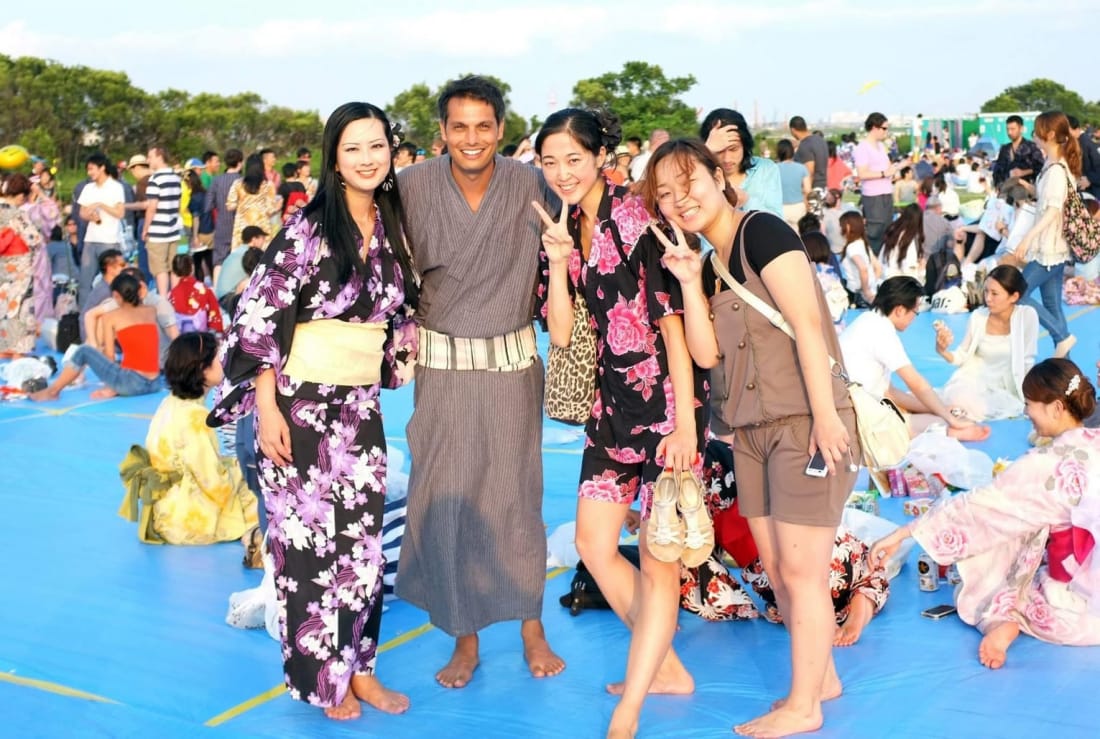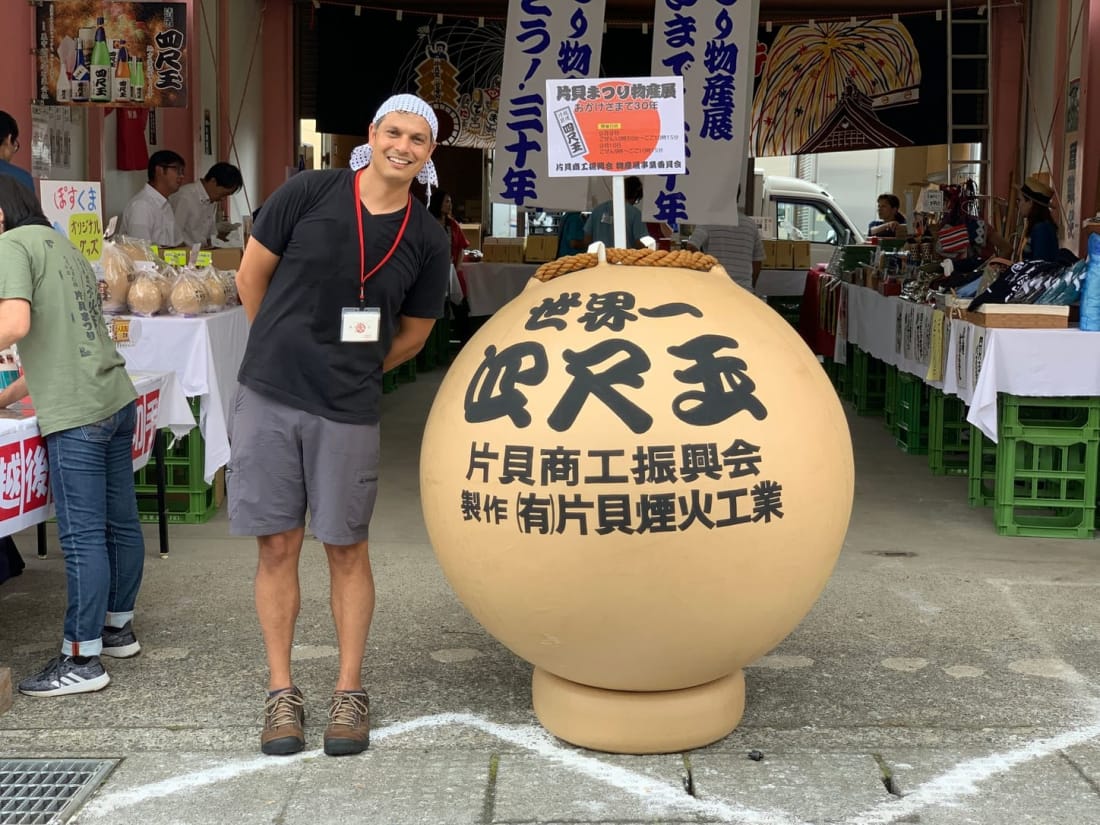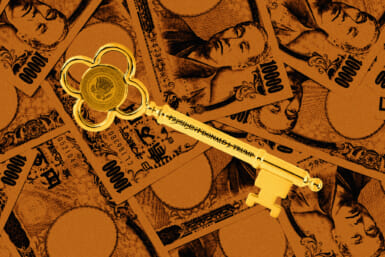In 1733, off the back of a century-long population explosion and a period of economic stagnation, a famine laid waste to the arable farmlands of Kyushu. Endless summer rainfall, the arrival of an epizootic disease (animal epidemic) and a ravenous plague of locusts grimly coincided. Crop yields were low, draft animals fell like dominos in the fields and the price of rice soared, causing thousands, if not hundreds of thousands, of deaths.
Later that year 20 explosive shells were launched into the heavens above a river tributary in Tokyo to commemorate the lives lost in the famine. The historic event gave rise to the annual Sumidagawa Fireworks Festival, which is still celebrated today.
“[That] was when the history of Japanese fireworks really started,” says Youtuber John Daub, who is aiming to reignite the country’s ill-fated 2020 hanabi (firework) season. “The origin of fireworks festivals in Japan comes from a pandemic, from a tragedy, from a time when lots of people lost their lives,” he continues. “The fireworks gave people hope.”

Daub launched a Kickstarter campaign to fund a firework show at the Omagari Autumn Fireworks event in Akita Prefecture on October 10, intended to mirror 1733 by paying homage to those who have lost their lives or livelihoods in the battle against Covid-19. “When I heard [the famine] story, I felt this was something that I had to do,” he says.
The Kickstarter campaign – live until September 6 – smashed its goal of ¥2,500,000 in the first 10 days, pushing the target up to ¥5,000,000, which if surpassed, would fund a second event in Katakai, Niigata Prefecture (date TBA).
The fireworks displays will feature watermelon-sized shakudama shells, which are too big to be fired in urban areas, and choregraphed explosives known as star mines. Daub will film documentaries leading up to both events, before livestreaming them to the public.
ONLY in JAPAN
Daub first came to Japan in 1998 and “caught the travel bug” before spending much of the 21st century periodically exploring, filming, eating, drinking and raconteuring his way up and down the country. This included a stint volunteering in the disaster-stricken Fukushima Prefecture following the triple core meltdown of 2011, and a three-month hitchhiking adventure in 2003, from Wakanai in northern Hokkaido to Kagoshima in southern Kyushu, with no more than $150 and a video camera to his name.
“You could see the soul of the country in the people who picked you up… and also in the faces of those who didn’t,” Daub laughs. “But that trip was a pivotal moment for making me stay in Japan”.
The combination of filming and travel experience led him to create the YouTube channel, ONLY in JAPAN, in 2012. “I wanted to correct the misconceptions of Japan that I had learned through hitchhiking, and to show people what the country was through my eyes.”
Daub eventually grew the channel to 1.5 million subscribers at the height of its fame, with production quality and polish more akin to a TV docuseries than a one-man vlog. However, as of July this year, Daub has moved on to another channel, called John Daub * ONLY in JAPAN, where he continues to create videos in the same vein, and where he’ll stream the 2020 hanabi events.
Fire in the Sky

“[The 2020 firework events] also go back to the origins of why I started ONLY in JAPAN,” says Daub. “Back in 2012 the country was hurting, Fukushima was a bad name, tourists weren’t coming… I see comparisons with 2020.”
Though it’s not surprising in a world of impermeable borders, since April Japan’s monthly tourism figures have been a consistent 99% lower than the previous year’s. Covid-19 has further crippled the economy by stunting the entertainment industry, disrupting the job market and forcing the government to appropriate funds for unprecedented stimulus packages. Just as he did following the travesties of 2011, Daub felt compelled to lend a helping hand.
A 2019 episode of ONLY in JAPAN featured the world’s largest single firework, the 930lb (420kg) Yonshakudama, which looks more like a wrecking ball than a bottle rocket and paints the sky with multiple cascading explosions the likes of which Gandalf the Grey would be proud.
Daub befriended the firework’s creator, Honda-san (whom he describes as equal parts genius and madman), and had grand plans to stream a firework event on YouTube for the now-postponed 2020 Olympics, along with the Japan Hanabi Association. The Games may have been scrapped from the calendar, but his desire to light the sky on fire was infallible. And now he had a reason.
“What’s stopping me from making my own fireworks show? How much would we need?” he put to his partners. Having run a successful Kickstarter campaign to film in HD his hitchhiking travails around Japan in 2017, he reasoned it was an avenue worth revisiting. Thus far, it’s been a resounding success, with the crowdfunding campaign on course to reach its ¥5,000,000 target.
A New Hope
Daub describes the opportunity to help the fireworks industry in small town Japan, while showing his foreign-based fans (stretching across all seven continents) the visual carnival of a Japanese hanabi festival as a “win, win.”
And given the frenzied excitement with which he talks about the aerial explosives, I’d wager he includes himself among the victors. “This is every boy’s dream is it not – to fire up bottle rockets?… But imagine you get something much bigger?”
While Daub is relishing the opportunity – and is hoping it serves as a blueprint for more livestreamed events in a world where the future of international travel remains uncertain – the poignancy has not been lost on him.
“We are in a time where we do feel hopeless; we’re trapped in our houses, we can’t do the things that we want to do; life is not going in the direction that we wanted it,” he says. “I’m hoping [these events] can bring some hope to people.”
Japan’s fireworks fans can learn more at John Daub’s Kickstarter campaign or at the YouTube channel John Daub * ONLY in JAPAN









